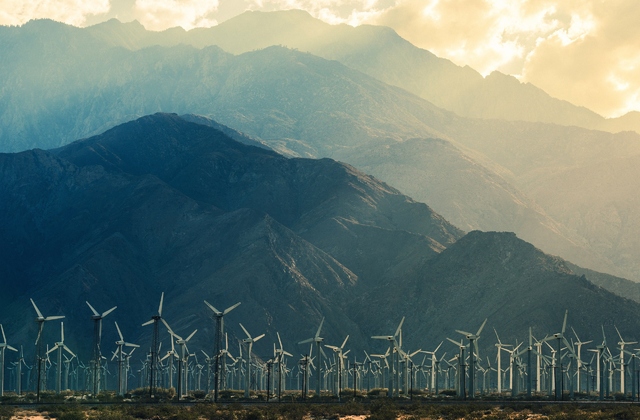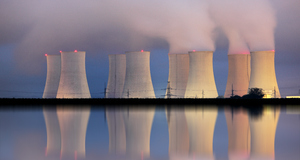Seeking Sustainability: Adopting Sustainable and Renewable Energy Sources to Create a Maintable World
By
2012, Vol. 4 No. 08 | pg. 1/1 Nelson Mandela once said, "You can never have an impact on society if you have not changed yourself." This quote is particularly applicable to the field of energy, and the transition from an unsustainable fossil fuel consuming world, to one based on sustainable living and renewable primary energy sources. Although many believe that embracing sustainability is not worth the time, money or effort, the truth is that the longer we wait to move to a sustainable based society, the worse off we are as a nation and a world. The need for renewable primary energy sources is possible to comprehend through discussion of both economic and social issues. Before exploring this subject in depth, it is important that to understand various definitions and concepts. When the topic of sustainability arises, it is often discussed arbitrarily without much thought into what it actually is. The Environmental Protection Agency defines sustainability in the following way:"Sustainability is based on a simple principle: Everything that we need for our survival and well-being depends, either directly or indirectly, on our natural environment. Sustainability creates and maintains the conditions under which humans and nature can exist in productive harmony, that permit fulfilling the social, economic and other requirements of present and future generations" (EPA). While this is a broad concept for one word to contain, it is an excellent representation of how we refer to sustainability. The next important concept is the difference between energy and power. There is a simple way to think about the difference between the two as long as one has a basic understanding of the concept of work, which is a force that displaces an object over a distance. With that in mind, energy is the ability to do work, whereas power is work over a specific time. Another important concept is that of a primary energy source. All of the energy we use comes from primary energy sources. According to Robert L. Evans, author of Fueling our Future: An Introduction to Sustainable Energy:
This concept is remarkably simple to understand when it is considered on such a scale. There are often many processes that occur between primary energy sources and energy consumption, such as carrying, storage, and end use conversion, but they must all eventually lead back to those three primary sources. Some major questions should now be answered before continuing to the topic, beginning with the all-important “why should I care about sustainability?” one of the best answers to this question is also one of the simplest. From Roy C. Dudgeon’s article on the very issue of caring about sustainability he states:
This statement allows us to understand that sustainability is vital to the flourishing of humans. Dudgeons depiction of why sustainability is crucial leads to the next question “Why can we not remain on fossil fuels?” This enquiry is easily answered when two concepts are understood. First, fossil fuels are not renewable, which means we cannot reuse them; once fossil fuels are used they are gone forever. The next concept is that fossil fuels are one of the three primary energy sources. If all fossil fuels are used up, then we must rely entirely on nuclear and renewable energy generation for all of our energy consumption. Taken to an extreme, if we rely entirely on fossil fuels until the instant that they run out, we will need to start enough nuclear and renewable energy generation to cover for the entire world’s energy consumption the second that the last bit of fossil fuels are burned. While this example may seem farfetched, according to the United States Energy Information Administration, in 2006, 86% of the United States energy consumption was derived from fossil fuel which is not far off from the 100% example used above (EIA). Now that these questions and concepts have been covered, it is possible to move onto the importance of embracing a sustainable society through the discussion of economic and social issues. Beginning with monetary issues, Delvin Lane, the head of Energy 360 at British Gas, once said “The cheapest kWh of energy is the one you don't use” (Lane). Economically this statement is very sound, however almost all of us use heaps of power every day. Power consumption has a serious effect on the economy of this nation as well as the economies of the world. In order to better understand the economics of power consumption and how it relates to sustainability it is critical to explore the two most dominant forms of energy consumption, transportation and heating and cooling. Transporting humans, goods, food, and energy takes a heaping percentage of the world’s energy consumption every day. For instance, according to David MacKay, author of Sustainability Without the Hot Air, the average consumption of a person in Britain is approximately 125 kwh/d per person. Transportation takes up about thirty five percent of this average daily consumption or roughly forty four kwh/d per person (MacKay 104). This is rather shocking, as that only leaves sixty five percent of energy consumption in Britain to all other energy consuming tasks. The next largest energy consumer is heating and cooling. Thirty four percent of Great Britain’s entire energy consumption is used for this application. This means that in Great Britain, a suitable example for many other modernized countries, around 43 kwh/d per person (104) is dedicated to keep them comfortable especially in the winter or summer months. The addition of transportation and heating and cooling shows that just less than seventy percent of all energy consumption in Great Britain is dedicated solely to those two things, moving stuff around quickly, and keeping them comfortable. Now many of us may be thinking “shame on the British” for dedicating so much energy to things not necessarily critical for the betterment or survival of our society, however, in the United States we should refrain from speaking too quickly, for the average American citizen consumes 250 kwh/d per person (MacKay 104), this is double the average British citizens consumption of energy. Some may be quick to argue that “this is an unfair representation of the United States lack of energy efficiency because we produce many more goods, and have a much higher gross domestic product than Great Britain, and this in turn inflates our energy consumption per person.” Unfortunately, while this argument seems legitimate, if one were to look at the ratios of average power consumption per person over GDP per capita, it is quite clear that GDP is not the dominating factor in determining the average power consumption per person. For instance the United States ratio of power consumption in watt hours per day per person to GDP per capita in dollars is about 250,000 over 42,000 which is a ratio of approximately 5.95. The United Kingdom has a ratio of approximately 3.79, and Hong Kong has a ratio of about 2.29 (Mackay 105). A lower ratio means that the GDP for that country is higher per unit of power consumed, which also means that the country’s population is more energy efficient per day. Taking these statistics into account and considering Hong Kong’s high standard of living as shown by their GDP and high ranking on the HDI or Human Development Index, we can conclude that more sustainable living does not correspond to economic burden (United Nations Development). In order to create solutions to embrace a more sustainable society, we must consider the economic effects of the decisions our private and public industries make as well as the decisions we make on our own. Publically, society can help to direct our nation to a more sustainable outlook by following the steps that other nations, like Hong Kong, have taken in order to decrease energy consumption while still maintaining economic growth and stability. Taking this track will allow us to incorporate public or government implementations that have worked best in other nations and skip the steps that were less successful, allowing us to learn from others mistakes. Using the government to focus on the major energy drains on our nation, like transportation and heating and cooling, will help to reduce energy consumption and strengthen our economy by reducing dependence on foreign oil and fossil fuels. Privately, one example of an economically sound solution to creating a more sustainable society is energy efficiency consultants that help industrial, commercial or residential customers to reduce energy costs all while reducing total energy consumption. Take for example a consultant who is able to add a geothermal heat pump, extra insulation, a trombe wall, and south facing windows into a building to reduce heating and cooling costs by a percentage at no cost to the customer. The customer could continue to pay the same rate on his/her energy bill until the costs of the energy efficient measures were covered, and the consultant was given their profit. Once the consultant was paid in full, the company could begin paying for the new cheaper bill that they essentially got for free. This is just one example of the many possible sustainable private applications that are economically feasible and helpful to the rest of our society with regards to lowering energy consumption. A simple solution for anyone to embrace more sustainable living while being financially savvy is to decrease power consumption. A simple task such as using a programmable thermostat that will reduce the use of heating or cooling devices in the home while one is away is a great way to reduce energy bills and embrace more sustainable living. Another solution along the same lines is to refrain from drastically changing the thermostat in summer and winter. While this may seem unappealing to some, according to David MacKay, “A human’s [general] perception of whether they feel warm depends on what they are doing, and what they have been doing for the last hour” (MacKay 143) he continues “Energy consumption of heating is reduced by… improving the control of temperature through thermostats, education, and the promotion of sweater wearing by sexy personalities” (MacKay 205). This shows that through something as uncomplicated as wearing a sweater while in one’s home instead of increasing the thermostat can help drastically decrease ones energy bill as well as supporting a sustainable lifestyle. While these solutions are just a few of the many that are economically sound and support a more sustainable world, it should now be clear that ecological living is not a harbinger of economic decline. Another topic related to embracing sustainability are social issues. Social issues play a major role in governing energy production and usage; this is displayed through government regulation and incentivizing as well as public opinion and marketing that changes public outlook. There are many fears and concerns over changing the general attitude of the world as it relates to sustainability. One of the most dominant social fears concerns nuclear power. The fear of nuclear power has come about due to several nuclear power plant accidents occurring in the last half of the twentieth century. In order to address the concerns over nuclear power we must first ask a few questions: is nuclear power a viable alternative to fossil fuels? Is nuclear power sustainable? And finally, is nuclear power safe? By addressing the costs and abundance of nuclear fuel, we can address the issue of nuclear power being a viable alternative to fossil fuels. According to David MacKay, nuclear fuels such as Uranium 235 and Uranium 238 are relatively abundant in the world especially considering the uranium contained in the ocean. While Uranium in the ocean is not necessarily easily accessible, current methods developed by Japanese researchers “have found a technique for extracting uranium from seawater at a cost of $100-300 per kilogram of uranium” (MacKay 165). An estimated total of the uranium in the world is 4.5 billion tons (MacKay 162). Adding this with other possible nuclear fuels allows us to remain relatively unconcerned with the total amount of usable nuclear fuels. To address the concern of costs, one must consider the price of obtaining uranium from both the ground and the ocean. MacKay goes on to note “Even a price of $300/kg (substantially higher than the current cost of $20/kg) would increase the cost of nuclear energy by only about .3 pence (or about .006 dollars) per kWh” (MacKay 166). To address the sustainability of nuclear power, the first thing to take note of is that nuclear power plants release no greenhouse gasses or toxic emissions into the air, which means virtually no air pollution comes from the use of nuclear power as a primary energy source. Another concern is the ability of nuclear power to last an extended period of time in order to meet the qualifications of being a sustainable solution. MacKay utilizes the numbers above as well as the ability of fast breeder nuclear reactors to turn nuclear fuels into usable energy and concludes
This data shows that nuclear power can be considered a sustainable resource, especially when considering that it would take 16,000 years to use up all of the approximated available uranium on earth. This figure does not even include any other nuclear fuels such as Thorium which according to MacKay is “about three times as abundant in the earths crust as Uranium” (MacKay 166). We need to finally address the safety of nuclear power before drawing any conclusions. While the media accentuates fear of nuclear power it is imperative that one addresses the facts concerning such a topic. One common fear that is constantly reiterated is the leaching of radiation from nuclear power plants to the surrounding area. While this concern is legitimate, Mara Hvistendahl of Scientific American notes that “[through research by the Oak Ridge National Laboratory] estimated radiation doses ingested by people living near coal plants were equal to or higher than doses for people living around nuclear facilities” (Hvistendahl 1). She goes on to note that “by burning away all the pesky carbon and other impurities, coal power plants produce heaps of radiation” (Hvistendahl 2). David MacKay also notes some of the media emphasized safety concerns related to nuclear power by addressing the deaths per Gigawatt-year of various power sources in the European Union. MacKay states “coal, lignite, and oil have the highest death rates, followed by peat and biomass-power, with death rates above 1 per GWy. Nuclear and wind are the best, with death rates below .2 per GWy” (MacKay 168). Through MacKay and Hvistendahl’s research, it is clear that the concerns about nuclear power are not necessarily backed up by factual evidence, but rather through fear mongering and biased media coverage. Solutions to social issues such as fear of nuclear power can come from various places. Intensified research into evidence supporting or thwarting claims by the media and other sources is one way to keep falsifications about viable sustainable solutions to current world problems out of the public realm. Another solution is to fact check information that one hears as well as accepting claims that are backed by strong evidence. Finally supporting government incentives or private industrial changes to more sustainable is a great way to advocate a transition to a more sustainable world. Through the discussion of economic and social issues, it is apparent that living sustainably is not an unfeasible task. Combining renewable and nuclear resources, as well as reducing consumption in transportation and heating and cooling can greatly help to reduce our dependency on unsustainable fossil fuels. Though many misconceptions and economic concerns about changes in our world plague sustainable incentives, the more that we embrace factual evidence, avoid media bias, and support evidence backed solutions to our current world problems, the faster we can move towards a sustainable environment in both our nation and our world. ReferencesAFP, ed. "Wind energy gathers steam, US biggest market: survey."Google.com. Association of Fundraising Professionals, 02 Feb 2009. Web. 4 Apr 2012. . Blume, Steven.Electric Power System Basics for the Nonelectrical Professional. 1st ed. New York City: Wiley-IEEE Press, 2007. 0-260. Print. Boyle, Rohan, Chris Greenwood, Alice Hohler, Michael Liebriech, Virginia Sonntag-O’Brien, Alice Tyne, and Eric Usher. "Global Trends in Sustainable Energy Investment."New Energy Finance. United Nations Environment Programme and New Energy Finance Ltd, 2008. Web. 4 Apr 2012. . Dudgeon, Roy. "Why people should care about sustainability."Helium. (2007): n. page. Web. 18 Apr. 2012. . Evans, Robert.Fueling our Future: An Introduction to Sustainable Energy. 1st ed. Cambridge: Cambridge University Press, 2007. 0-192. Print. Hvistendahl , Mara. "Coal Ash Is More Radioactive than Nuclear Waste."Scientific American. (2007): n. page. Web. 24 Apr. 2012. . Jacobson, Mark. "Review of solutions to global warming, air pollution, and energy security."Energy & Environmental Science. (2009): 148-173. Web. 4 Apr. 2012. . Lane, Delvin. "Water, Energy & Environment."Energy Event. 73 (2011): n. page. Web. 19 Apr. 2012. . Leone, Steve. "Political Reality and the Way Forward for Renewable Energy."Renewable Energy World. (2012): n. page. Web. 4 Apr. 2012. MacKay, David.Sustainable Energy - Without the Hot Air. 1st ed. 1. Cambridge: UIT, 2009. 0-380. Print. Nelson, Mandela. "Nelson Mandela Quotes."goodreads. Goodreads Inc, 21 May 2012. Web. 21 May 2012. . Pieters, Janneke. "Hydropower\'s Devices Beyond Dams."Renewable Energy World. Renewable Energy World, 23 Mar 2012. Web. 4 Apr 2012. UCS. "Benefits of Renewable Energy Use."Clean Energy. Union of Concerned Scientists, 1999. Web. 4 Apr 2012. United Nations. United Nations Development Programme. Human Development Index. 2010. Web. . United States. Energy Information Administration.Renewable Energy Consumption and Electricity Preliminary 2006 Statistics. Washington D.C.: , 2997. Web. . United States. Environmental Protection Agency.What is sustainability?. Washington D.C.: United States, 2012. Web. World Nuclear Association, . "Nuclear Power in France."World Nuclear Association. N.p., Feb 2012. Web. 24 Apr 2012. "William Shakespeare." BrainyQuote.com. Xplore Inc, 2012. 18 May. 2012. . Suggested Reading from Inquiries Journal
Inquiries Journal provides undergraduate and graduate students around the world a platform for the wide dissemination of academic work over a range of core disciplines. Representing the work of students from hundreds of institutions around the globe, Inquiries Journal's large database of academic articles is completely free. Learn more | Blog | Submit Latest in Environmental Studies |



















